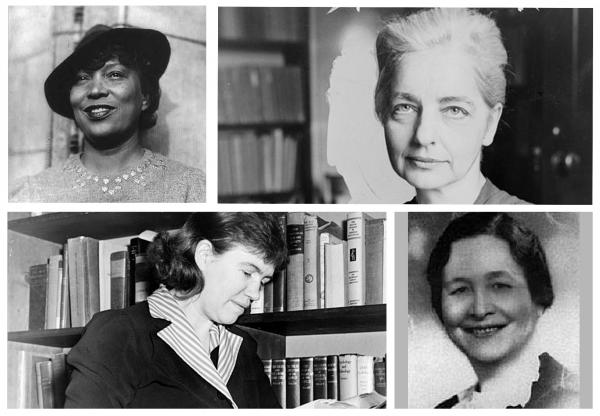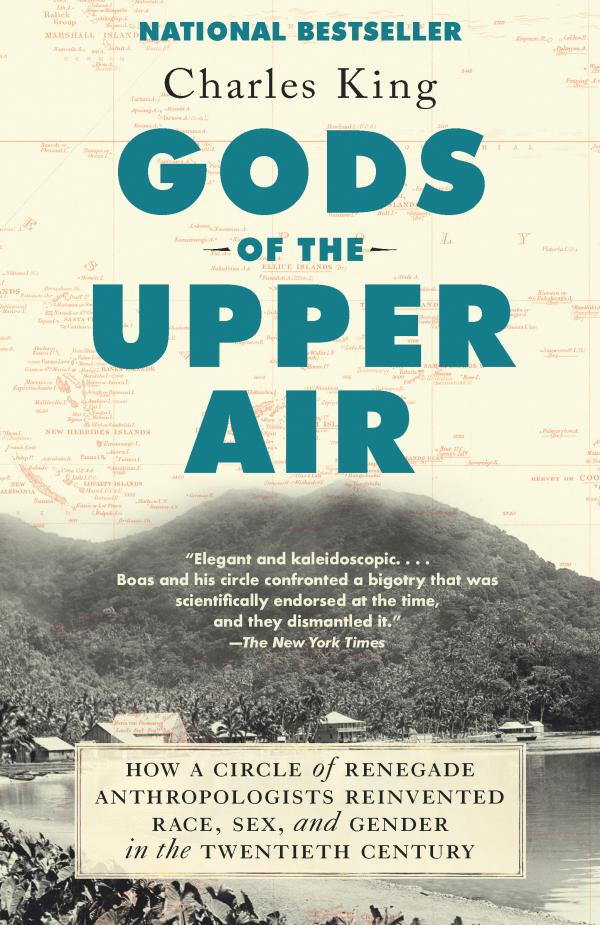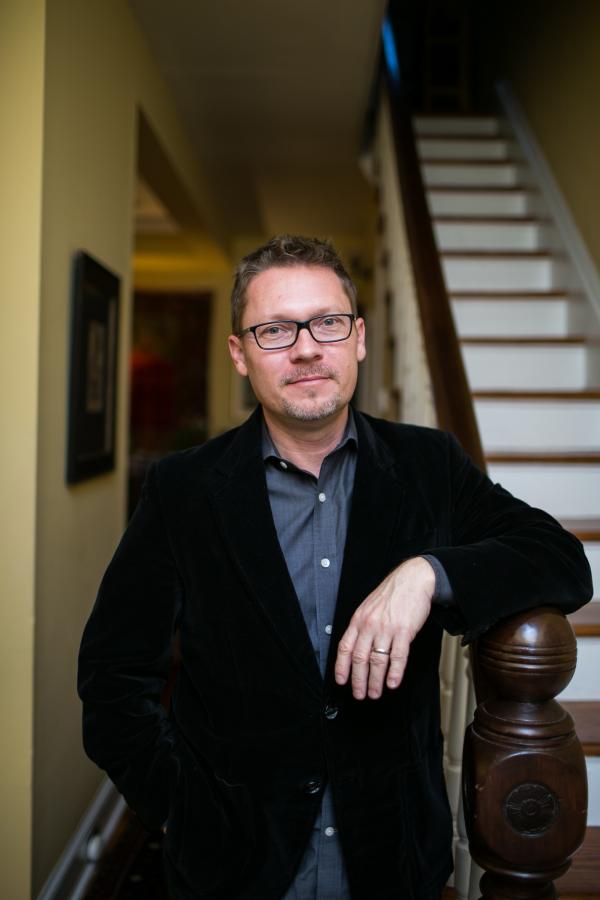Gods of the Upper Air: A Q&A with NEH Public Scholar Charles King

Clockwise, from the top left: The anthropologists and authors Zora Neale Hurston, Ruth Benedict, Margaret Mead, and Ella Cara Deloria.
Library of Congress, Prints and Photographs Division, LC-USZ62-62394 (Neale Hurston), LC-USZ62-114649 (Benedict), LC-USZ62-120226 (Mead); Akta Lakota Museum & Cultural Center (Deloria)

Clockwise, from the top left: The anthropologists and authors Zora Neale Hurston, Ruth Benedict, Margaret Mead, and Ella Cara Deloria.
Library of Congress, Prints and Photographs Division, LC-USZ62-62394 (Neale Hurston), LC-USZ62-114649 (Benedict), LC-USZ62-120226 (Mead); Akta Lakota Museum & Cultural Center (Deloria)
We rarely consider researchers to be as interesting as the research they conduct. Yet in Gods of the Upper Air: How a Circle of Anthropologists Reinvented Race, Sex, and Gender in the Twentieth Century, NEH Public Scholar Charles King proves otherwise. His book tracks the development of American anthropology through the intertwined lives of prominent anthropologists. Starting with Franz Boas, the “Father of American Anthropology,” and then moving to his students Ruth Benedict, Margaret Mead, Zora Neale Hurston, and Ella Deloria, King’s book shows how these pioneering social theorists were also interesting public figures in their own right. As scholars, authors, and activists, they used their personal and anthropological experiences to challenge long-held ideas about race, sex, and gender. As King writes, Boas’s work “was a blueprint for how anthropology might turn itself into the most hopeful of sciences, one whose job was not just to catalog the many ways of being human but also, in a way, to love them.” In a time when the discipline of anthropology is struggling with its own history, King's work on Boas and his circle is a useful reflection on how early scholars helped shape the field.
I caught up with Charles King to discuss how Gods of the Upper Air moved from the archives to the bookshelf.
Your title is eye-catching. The first part of the title–Gods of the Upper Air–is a quotation by anthropologist and author Zora Neale Hurston, and the second part calls your group of anthropologists “renegades.” What does Gods of the Upper Air refer to and in what way were these anthropologists renegades?
As you point out, I owe the title to Zora Neale Hurston. The phrase comes from a redacted passage in her memoir, Dust Tracks on a Road. She is referring to a certain perspective on the world that comes with experience, with travel, with engagement with other societies and people very different from oneself. It’s the perspective of seeing the world and its differences from on high, where the distinctions that mean so much to us here and now begin to fade away. Elsewhere, she contrasted the “gods of the upper air” with the “gods of the pigeonholes.” I struggled a lot with the title for this book—my publisher was getting increasingly nervous that we had a book manuscript but no title in the run-up to the publication date—and when I read the Hurston passage, I thought this was just the perfect way of encapsulating what I wanted to say. And the fact that Hurston—whom we know as a novelist more than as a social scientist—gets top billing is particularly appealing to me. I’m convinced that she is one of our great unremembered social theorists.
Hurston and her associates were renegades in the sense that they were pushing back against the dominant truths of their day: that people come prepackaged in things we call races; that there are only two natural genders, each with its own specific social role; that the United States and a select group of western European countries are at the top of a civilizational hierarchy. They questioned each of these ideas not through the medium of ethics, morality, or religion, but rather through science. Their technique was to go around the world to observe how other cultures and civilizations did things, how they solved some of the basic problems of human life, from rearing a child to dealing with aging parents. What they discovered is that the answers we give to these questions—summer camp for the kids and a retirement home for the parents, say—aren’t universal. They certainly aren’t the only—or even best—route to happiness and a stable society. In the process, this group of social scientists helped us dethrone ourselves and begin to look at our own society critically and skeptically.
As a professor of international affairs and government, how did you end up diving into the history of American anthropology?
This is a history book about social scientists, so it brings together a lot of themes I have been interested in for some time. I’ve written several books about eastern Europe, nationalism, the making and unmaking of states and empires. But at some point, I realized that an underlying theme was how states become interested in human difference—how they build the categories of difference that we come to take as givens and then use those categories for the purposes of governance or social control: race, ethnicity, gender, sexuality, and so on. So, even though I’m writing about anthropologists, the book is very much about how social power works, which of course is a key topic of interest to political scientists. Plus, I should also say that it helps that I’m married to a person with a Ph.D. in anthropology, the writer Maggie Paxson. Years and years of conversations with her were critical to my understanding of the field and to how an anthropologist’s brain makes sense of the world. Maggie was also working on her own book--The Plateau (Riverhead, 2019), about a small French village and its heroic defense of refugees in the Second World War and today-- while I was working on mine, so the two projects proceeded in tandem. And both of them get at a similar theme: the essential connectedness of us all.
You begin the book with the long road Franz Boas took as a scholar from undergraduate student to “Papa Franz,” as his students called him. How did he come to be called “the Father of American Anthropology,” as generations of scholars have referred to him? Does he deserve that title?
I think there are two reasons for Boas’s prominent place in the history of American anthropology. First, he and his circle elaborated the discipline’s core methodological principle: cultural relativism—the assumption that there are no higher, lower, better, or worse ways of solving basic human problems, such as what to eat, how to marry well, or how to die properly. Without this principle, you simply couldn’t do social or cultural anthropology (or most other social sciences, really). You have to go into the field and try, as much as you can, to suspend any judgment about the things you are witnessing and try to understand human behavior in ways that make sense locally, not according to your own predispositions and preferences. Second, Boas helped to organize the basic apparatus of the discipline—journals, conferences, associations—and seeded his graduate students (at least the male ones) among new departments of anthropology that were emerging across the country, from Chicago to Berkeley, plus of course his own home department at Columbia University. So in both senses, Boas was a fundamental figure.
Why anthropologists, and why now? What legacy do you hope to bring to the public’s attention?
Not many people would want to read a history of a social scientific discipline, except for the small band of scholars who are already interested in such things. The bigger story I’m trying to tell in this book is about the emergence of a certain way of seeing the world, which I believe Boas and his students were responsible for helping to bring to a wider public. The principal figure here is Margaret Mead, who was not only a brilliant social scientist in her own right but also a key translator of Boasian ideas to a broad readership, through her bestselling books, her columns in glossy magazines, and her public speaking and media appearances. If someone can name an anthropologist, the one they know is still probably Margaret Mead; that fact speaks volumes about her lasting influence.
The basic idea that she and others were trying to convey is that we have to look at our own society with clear-eyed vision, to alienate ourselves from the things we take as natural, given, and obvious. Once you do that, social change becomes possible. You begin to see that the way your society is structured is actually absurd, or harmful, or constraining of human potential in some way. It’s one thing to be motivated by righting a wrong or correcting an injustice. But Boas, Mead, and others sensed that a very powerful engine of social change is that moment when some existing social practice comes to appear stupid or nonsensical to the people who have been practicing it—in other words, it comes to appear alien to our basic sense of who we are. You only have to look at our own engagement with race, police brutality, gender identification, sexual orientation, and a host of other pressing social issues to see this process at work. It’s not just a moral awakening but also a wholesale shift in society’s sense of normalcy. That is the self-critical worldview that Boas and his students were trying to further.
Many think of Margaret Mead in terms of her sometimes-controversial private life. How did you approach discussing such a high-profile figure without losing focus on your bigger goals for the book?
I do deal in some detail with Mead’s private life—in fact, with the private lives of all the key figures in my book—but I’m always astounded that people would still find Mead to be controversial. She had love affairs, which isn’t unusual, and got married three times, which many people manage. She wrote about sexuality with a frankness that was somewhat ahead of her time, which I think accounts for how she is often remembered.
It was important to me to bring the personal lives of these thinkers into the narrative. Their personal experiences were very much a part of their theorizing about society. They all fit uncomfortably in their own time and place: Boas, a German-Jewish immigrant; Mead, an ambitious, world-traveling woman who was also involved romantically with both women and men; Hurston, the only African American undergraduate at Barnard College; Ruth Benedict, trying to have an academic career at a time when professorships at Columbia University were all but closed to women. At some point, each of them had the same kind of realization about their own personal struggles: either there is something deeply wrong with me—I’m defective or broken in some way—or there is something wrong with the society that I’m surrounded by. In that germ of a personal crisis lay an entire social theory about the relationship between an individual and social circumstance. So, biography was very much a part of the bigger historical narrative I wanted to convey.
Throughout your extensive research for this book, did anything surprise you?
I love doing archival research, and there are always gems to be found: little bits of paper, or a photograph, or some artifact that you didn’t expect to find. I’ve held bits of fern, still green and beautiful, that Boas collected on Baffin Island in the 1880s. I’ve trawled through Mead’s field notebooks and her love letters, and have seen how some of her correspondents, in fits of rage, stabbed the nib of their fountain pen into the paper. I’ve seen what Ruth Benedict had in her purse when she died (among other things, some anthropological notes she had been jotting down). I was flabbergasted at what a collector Mead was. My project would have been impossible without her archive, now housed at the Library of Congress. She saved absolutely everything—there are around half a million items in her papers, of which I saw only a fraction. It is a stunning record not only of her life but, in a way, of twentieth-century American intellectual history, since she was in correspondence with virtually everyone who had something to say about social science, education, public policy, and many other fields.
What sources did you use in your research?
The Mead archive was critical, as were several other archival collections in New York, Philadelphia, and elsewhere. I visited Mead’s hometown and gravesite, and made a pilgrimage to Eatonville, Florida, where Hurston grew up, and then took a drive across the state to the small cemetery where she is buried, on the Atlantic coast. (Despite the headstone, the precise location is unknown, since her grave went unmarked when she died.) I couldn't have written some of the Hurston chapters without seeing these places myself, and I think that experience also made me appreciate Hurston’s central role in this story in ways that I hadn’t quite understood before.
With a large ensemble of people discussed here, there must have been so much material to read. Is there something that you wanted to include that you had to cut?
My editor, Kris Puopolo at Doubleday, was very kind about allowing the book to be the length it needed to be, so I don’t think much was cut in the end. What I did have to work a lot on was creating a sense of forward movement in a long and complicated story, a narrative that stretches from Boas’s birth in the 1850s to Mead’s death in the 1970s. The story is also interlaced with non-narrative sections—I call them step-backs, but I’m not sure that’s the right term—that provide the reader with some context for what is happening in the lives of the central characters. I wanted this book, more than those I’ve written in the past, to have the feel of one narrative line, even if the narrative runs through different characters in different chapters. The book is about the emergence of an idea or a way of seeing the world, and it was a challenge to make that work as a matter of form.
Where will you go from here? As a scholar with many international research interests, will your next project be set in US, or will you adventure abroad again?
I keep setting new goals for myself as an academic and as a writer. I’ve long wanted to do a book with a single narrative line, but I’m not sure I’ll manage to find the right vehicle for that. I so admire writers such as Casey Cep, Patrick Radden Keefe, David Grann, T. J. Stiles, Candice Millard, Sarah Bakewell, Jill Lepore, John Vaillant, Isabel Wilkerson—real masters of nonfiction form, in different ways, and all with a deep seriousness of purpose. I always find myself trying to reverse-engineer what they have done and then to apply those lessons to my own practice. I’m certainly working on another book—I just haven’t settled on which one yet. And I can’t end this interview without thanking the National Endowment for the Humanities for the Public Scholars award that I received in 2017. I am so thankful for this support, as well as the broader initiative to encourage public scholarship among American writers and academics.
Charles King received an NEH Public Scholars award (FZ-250287-16) to support research for Gods of the Upper Air: How a Circle of Renegade Anthropologists Reinvented Race, Sex, and Gender in the Twentieth Century (Doubleday, 2019). The book won the 2020 Anisfield-Wolf Book Award for Nonfiction of the Cleveland Foundation and the 2020 Francis Parkman Prize of the Society of American Historians
The Public Scholars program supports well-researched books in the humanities written for the general public. For more information on the NEH Public Scholars program, or to apply, see the program’s resource page. Contact @email with questions.





